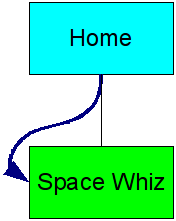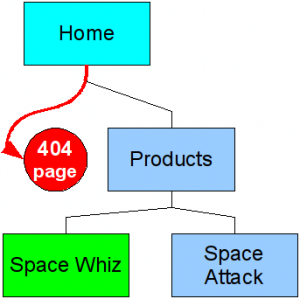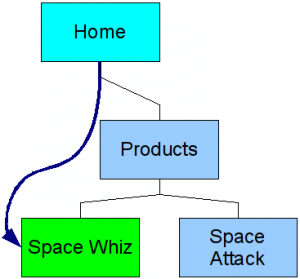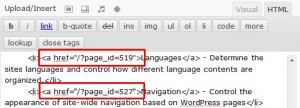WPML’s Sticky Links are internal links between pages and posts, which follow their destinations and automatically update when target URLs change.
Despite their similar (and confusing) name, they have nothing to do with WordPress Sticky Posts and Pages.
What Sticky Links do
Let’s start with an example:
Supposing there are just two pages in our website – a Home page and a page called Space Whiz (our latest and greatest and only product). From Home there’s a link to Space Whiz. We’re using fancy URLs so its address is:
oursite.com/space-whiz/
Space Whiz is doing great so we’re writing a sequel – Space Attack. We’re creating a new Products page, making it the parent page of both our programs. So now, we have:
oursite.com/products/ oursite.com/products/space-attack/ oursite.com/products/space-whiz/
What’s going to happen to our home page link that points to oursite.com/space-whiz/?
It’s pointing at the wrong place. The URL for that page is changing to oursite.com/products/space-whiz/ (WordPress cleverly redirects to the new URL, but this is done based on guesswork. I can tell you more about it if you’re interested).
Wouldn’t it be nice if that home page link magically updated to the correct URL?
This is exactly what Sticky Links do.
When Sticky Links are enabled, all internal links between pages and posts update automatically when their URLs change. If a page’s URL (permalink) changes, all links to it will update instantly.
This might illustrate it a bit better.
Without Sticky Links
| Before | After |
|---|---|
 |
 |
With Sticky Links
| Before | After |
|---|---|
 |
 |
Have you ever done drawings in MS Word (or OpenOffice)? To connect objects, you can either draw lines or place connectors. Lines just point somewhere. Connectors point to objects. When the objects move, connectors follow. Lines just keep pointing to where the objects used to be.
WPML’s Sticky Links are like connectors. They track where pages go and follow them – hence the name.
How WPML’s Sticky Links work
With Sticky Links enabled, WPML does two things:
- When posts and pages are saved it changes all URLs to Sticky.
- When pages are displayed it calculates the actual URLs for links.

When you save a page or a post, WPML checks for links to other pages or posts. It replaces all such links with default style links. Instead of saving <a href=”http://oursite.com/space-whiz/”>, it will save <a href=”/?page_id=5″> (or whatever the page ID is). This is the default style URL.
Then, when the page is displayed, WPML replaces back all the links to their current URLs. When the Space Wiz URL is http://oursite.com/space-whiz/, this is what you’ll get. When it changes, the links in all pages update immediately.
Enabling and disabling Sticky Links
WPML makes it easy to start and stop using Sticky Links. The Sticky Links admin screen can scan all existing contents and convert ordinary links into Sticky. In so doing, it will also warn you about broken links and suggest possible alternatives.
If you don’t want to use Sticky Links any more, you can revert them to the current permalinks. WPML will run through all pages on posts in the database and change the links back.
Do visitors see any of this?
No. It’s all internal. Visitors will always see the current permalinks in links. The Sticky Links are only visible when you edit pages. Then, you will see the default WordPress links instead of fancy links.
When visitors view your pages (or when you preview them), it’s all fancy links.
What happens if I decide to change the permalink structure?
Great question! I’m glad you asked that.
This is where Sticky Links really shine. You can change the permalink structure ten times a day and nothing will break. Since the links between pages are calculated when pages are displayed, all the links between pages and posts will always be correct – no matter what you change.
Any feedback?
I hope this explains WPML’s Sticky Links better. What do you think about this? Do you find it a useful feature? Any ideas for improvements?
